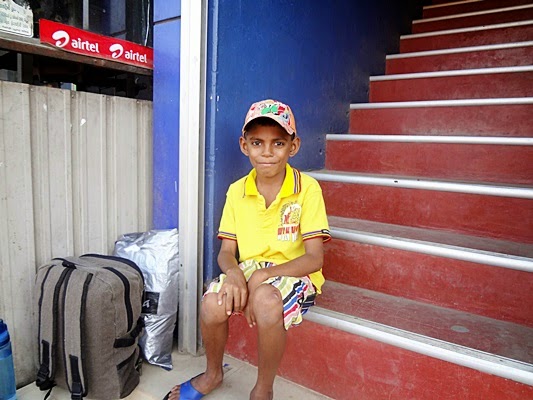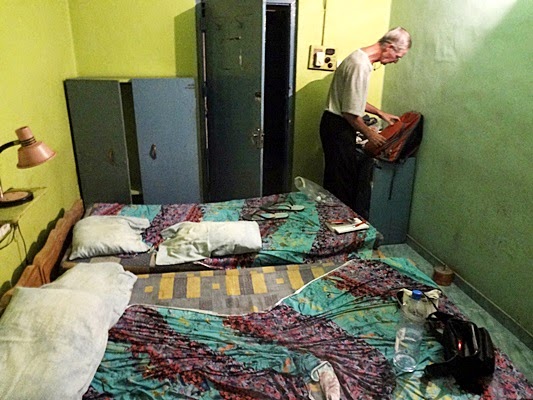Rathnapura is the gem mining center of Sri Lanka. We arrived in Rathnapura with a room reservation for $40/night but felt we should look for something cheaper. Myra and I took off after a light breakfast near the bus stand and went hunting for rooms. Lots of people, tuk-tuks and stalls selling stuff, but no rooms to be found.
The demand for rooms outstrips the supply here and especially on weekends. It's a Sunday and we couldn't find rooms near the bus station.
We stumbled onto the Orchard Villa and decided to check out the price and availability as it was the only place we found to stay in our mile-square walk. Several young men showed us two rooms that we could have for 12 hours. They agreed to let us stay overnight as long as we were gone by 9:30 the next morning. They claimed the rooms were reserved for the next night, but we think they were a little shady. These nice, brand new rooms were huge, but pretty empty and they let us have them for 1500 rupees/night, about $12. We think they were renting the rooms before the place officially opened up, but we don't really know.
The view from our room shows a sitting Buddha statue at the top of the hill next to the tower.The second night in Rathnapura, we stayed at an inn on the top of the hill above the bus stand. Nice views.
View from our inn in Rathnapura.
Jason and Myra on the veranda at the inn.
This kid was giving me a big toothy smile until I went to take his photo.
Jason was dogged by this man until he relented and listened to his proposal. Mr Master offered to take us to see the sights of the area for the whole day for 1500 rupees and his bus fare and lunch. We discussed it at the inn and agreed it sounded good. He met us at 9 AM and took us to a gem mine where all the work is done the traditional way. We stepped through that fence below and headed down a dirt track to the mine.
This is the mine hole. The hole is about 20 feet deep so far and is shored up by rubber tree logs and ferns. The hole fills with water and they must pump it out to dig during the day.
Looking down into the mine, you can see the water level. It must be pumped out before they can dig.
The miners have built an earthen oven and a pot of rice and hot water for tea were hot on the cracked mud hearth.
The water is being pumped out of the hole. Miners get 3% of the find's profits generally, If the mine shaft gets very deep or goes horizontal at the bottom, they might get up to 5%.
Looking down into the mine, the water is still coming out.
Now we see the gem-bearing sands/mud. The miners scoop it out by the shovelful and toss the wet mud mix up to be dumped onto the"wash pile" that will be washed and sorted for sapphires, rubies, spinels, tourmaline, and other precious gems that are all found in these mines. Only diamonds and emeralds are not found here. One mine can produce a rich mix of valuable stones.
The workers get a rhythm going where they toss up the basket of mud/sand to the next guy up the line. There is one digging on the bottom of the shaft, and two intermediate guys tossing the full basket up to the next guy. The final guy dumps the contents out and returns the basket to the man who then drops the empty basket down just as he's catching the next full one coming up. Pretty coordinated!
This is the "wash pile" where the diggings are dumped until wash day, about every 2 weeks. Nobody is allowed to go through the diggings until all the shareholders and owners are present on wash day. The workers can keep the small stones, but big, valuable ones are bundled and word sent out to the gem dealers to come see what's been found. Dealers write their bid on paper and roll it up and put it into a sealed box. The highest bidder wins the stones and the money is then divvied up amongst the folks entitled to a share.
This guy is ready to drop the empty basket as he catches the one coming up. One errant dump on the pile splashed me and I wore mud and sand spots all day and had to wash my clothes in the sink in the inn.
This guy dug out some old tailings to demonstrate the traditional way they wash the gem gravel in the water hole here. They use woven reed baskets and swish and break up the mud with their hands. The technique is a lot like panning for gold as the gemstones are heavy and sink to the center of the basket.
Breaking up and swishing the mud/gravel mix to reach just gravel and stones. This one basket turned out 4 colored stones that they let us keep for souvenirs. Myra kept a purple one and I got a chip of tourmaline and 2 "dead stones", the ones they feel don't let the light through enough to be valuable. But they were bigger than the sapphires I mined myself in Australia so I was thrilled with the whole process and the results. I could've spent all day here!
The result of this basket is this collection of gravel and stones. It turne dout at least four gem bits.
The heart of Rathnapura.
Note the bamboo stalks that act as the construction poles above and on the left below. The gem buyers often operated from an area just off the clock tower.
View from the bar/restaurant we found to have a beer and a mediocre meal
Lunch with Mr. Master during our day tour. We had a buffet of curries and for a little man, he could certainly pack in the food. After lunch, we went to a gem museum and jewelry maker. Myra bought some earrings, but the gems here still aren't cheap and I just couldn't justify the prices, so I came away empty-handed except for a large chunk of quartz that the miners gave me (said it was a good sign) and the small stones they found in the junk wash and gave us.
After the gem museum we visited a tea factory here. They wouldn't let us photograph the production process, but it was ok to take pictures at the end of the tour where these women scooped the processed tea into the large paper bags to be sent to auction.
We had to wear paper booties and hair nets as we walked through the factory. We saw where they dumped the tea leaves in to be dried. Then the leaves are conveyed to a shaker/sorter where the leaves are sorted from the stems. Broken Orange Pekoe (BOP) was the primary tea they produced here.
Looking back at Myra next to the big bags to be sent to auction.
One person hand stencils the date and type of tea onto the paper bags. Isn't Jason cute in his hair net?
Paraic, Mr. Master, Jason, Karen and Myra with a tea worker at the plant where Sithaka brand tea is produced
They didn't even offer us a cup of tea?! But they showed us to the collection of caged parrots outside the office.
The beak that would eat fingers if allowed.
Who are you looking at?
We were warned to keep our fingers away from these guys.
This grey one wanted to get to us in the worst way.
The outside of the tea factory. They aren't huge plants and are unobtrusive in view.
We rock-hopped up to a waterfall for the final event in the day. Along the creek, lots of boys and young men were frolicking in the water and washing themselves.
The waterfall. Not much to write home about, really, but it was pleasant. Myra and I were the only two females I saw around here.
Mr. Master viewing the water.
It looked inviting, but it was too far to get into the fall itself and we weren't dressed to get wet.
Jason, Mr. Master and Myra on the rocks at the waterfall. Myra is cooling her feet in the cold water.
She said the little fish were coming to nibble on her feet.
Karen on a rock at the waterfall outside of Rathnapura,
Going back down the rocky creek bed.
Heading back down ,the water sluicing over some smooth rocks.
Our rooms at the inn were pretty shoddy. This slug was crawling across the wall near the ceiling while Jason took a shower. The ceilings were barely high enough for him to stand and the paint was peeling badly.
The room at the inn was not our favorite place to stay. We got what we paid for, I guess.
The bathroom in our room at the inn. Deplorable, but more common than you'd think.
We enjoyed the mining area of Rathnapura and spent two nights here. With Mr. Master's help, we saw a lot in a single day's tour. We could never have seen all the stuff we did without a local's help. We never had to wait for a bus, except coming back from the waterfall. Since it was Saturday, there was only one bus and it was an hour wait. But a tea factory employee bus came by and we were welcomed aboard to get back to the main road to catch a bus back to town. Jason showed the drive the tea I'd bought to convince him we were worthy of the free ride. Next stop, Kandy.


















































